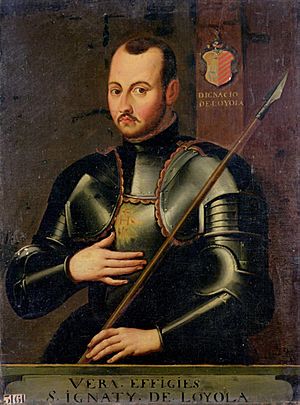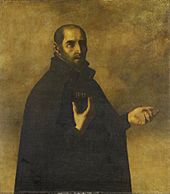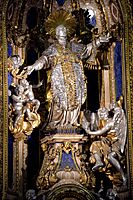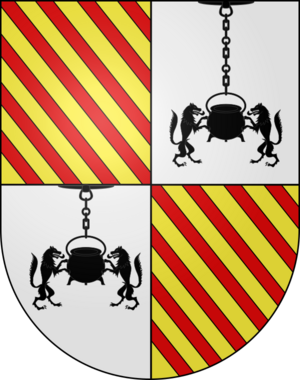Ignatius of Loyola facts for kids
Quick facts for kids SaintIgnatius of Loyola S.J. |
|
|---|---|

Ignatius of Loyola, anonymous 16th-c.
|
|
| Priest, Confessor, Founder of the Society of Jesus | |
| Born | Iñigo López de Oñaz y Loyola 23 October 1491 Azpeitia, Gipuzkoa, Crown of Castile |
| Died | 31 July 1556 (aged 64) Rome, Papal States |
| Venerated in | |
| Beatified | 27 July 1609, Rome, Papal States by Pope Paul V |
| Canonized | 12 March 1622, Rome, Papal States by Pope Gregory XV |
| Feast | 31 July |
| Attributes | Sacerdotal vestments, cassock, ferraiolo, biretta, holding a book with "Ad maiorem Dei gloriam" inscription, trampling on a heretic, IHS Christogram, crucifix, and a rosary |
| Patronage |
|
| Major works | Ignatian spirituality |
Saint Ignatius of Loyola (born Íñigo López de Oñaz y Loyola; around October 23, 1491 – July 31, 1556) was a Spanish Catholic priest. He founded a religious group called the Society of Jesus (the Jesuits) with his friends, Peter Faber and Francis Xavier. He became their first leader in 1541. Ignatius wanted the Jesuits to focus on missionary work and teaching.
Jesuits take special vows. Besides the usual vows of chastity, obedience, and poverty, they also promise to obey the Pope. This means they are ready to go wherever the Pope sends them. The Jesuits played a big part in the Counter-Reformation, which was a time of renewal in the Catholic Church.
Ignatius was once a soldier. He created a special way for people to grow spiritually. He wrote down his ideas in a book called Spiritual Exercises (1548). This method is now known as Ignatian spirituality.
Ignatius of Loyola was declared a blessed person in 1609. He became a saint on March 12, 1622. His feast day is celebrated every year on July 31. He is the patron saint of the Basque areas of Gipuzkoa and Biscay. He is also the patron saint of the Society of Jesus. In 1922, Pope Pius XI named him the patron saint of all spiritual retreats.
Contents
Early Life and Family
Ignatius of Loyola was born Íñigo López de Oñaz y Loyola. He was born in a castle in Azpeitia, a town in the Basque region of Spain. His parents, Don Beltrán and Doña María, were from a noble family. They were involved in local conflicts.
Íñigo was the youngest of their thirteen children. His older brother, Juan Pérez, was a soldier but died in battle.
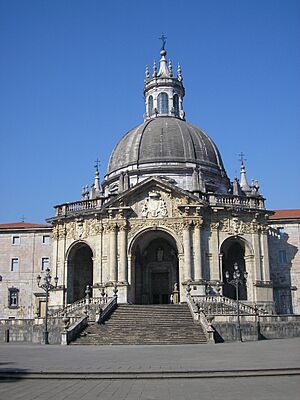
He was named "Íñigo" after a saint. Later, he started using the name "Ignatius." This name was easier for people in France and Italy to understand. He also used "de Loyola" to show he was from the village of Loyola.
Íñigo's mother died soon after he was born. He was cared for by María de Garín, a local blacksmith's wife. When he was seven, he returned to his family's castle. His family thought he might become a priest.
A Soldier's Path
Instead of becoming a priest, Íñigo became a page for a relative, Juan Velázquez de Cuéllar. Juan was a treasurer for the kingdom of Castile. During this time, Íñigo enjoyed dancing, fencing, and gambling. He dreamed of becoming famous like the knights in stories.
He joined the army when he was seventeen. He was known for being a fancy dresser and a skilled swordsman. In 1509, he fought for Antonio Manrique de Lara. He was good at diplomacy and leadership.
In 1521, Íñigo was badly hurt during the Battle of Pamplona. A cannonball hit his leg, shattering it. He was taken back to his family's castle. He had several painful surgeries. His right leg ended up shorter than the other. He limped for the rest of his life, and his military career was over.
A New Direction: Spiritual Conversion
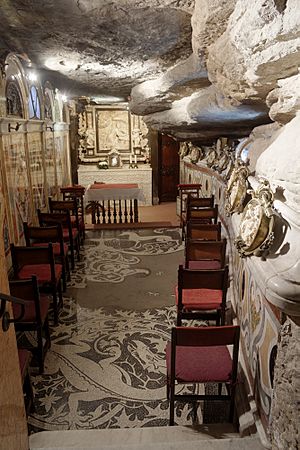
While recovering from his injury, Íñigo began to change. He asked for his favorite adventure books, but there were none. Instead, he was given books about the life of Jesus and the lives of saints.
One book, De Vita Christi, deeply affected him. It made him want to dedicate his life to God. He wanted to follow the example of saints like Francis of Assisi. This book also taught him a way to meditate. It suggested imagining yourself in the Bible stories. This idea became a key part of his Spiritual Exercises.
Íñigo noticed something important. When he thought about being a knight, he felt empty afterward. But when he thought about living like a saint, he felt joy and peace. This was his first lesson in understanding God's will.
After he could walk again, Íñigo decided to go on a pilgrimage to the Holy Land. He wanted to visit the places where Jesus lived. He also wanted to do stricter penances, or acts of self-punishment for sins. He felt sure about his plan after seeing a vision of the Virgin Mary and baby Jesus.
In March 1522, he visited a monastery. There, he confessed his past sins. He gave his nice clothes to the poor and put on simple clothes. He left his sword and dagger at the Virgin Mary's altar.
From there, he walked to Manresa where he lived for about a year. He begged for food and did chores at a hospital. He spent many hours praying in a nearby cave. During this time, he developed the main ideas for his Spiritual Exercises.
Years of Study
In September 1523, Íñigo traveled to the Holy Land. He wanted to live there, but he was sent back to Europe by the Franciscans.
He returned to Spain and started grammar school at age 33. He then went to the University of Alcalá to study theology and Latin.
While studying, he met some religious women who were questioned by the Spanish Inquisition. Ignatius was also questioned because he was preaching without a theology degree. He was later released.
After these events, Íñigo changed his name to Ignatius. He moved to France to study at the University of Paris. There, he met six other students who would become his first companions. They were Alfonso Salmeron, Diego Laynez, Nicholas Bobadilla, Simão Rodrigues, Francis Xavier, and Peter Faber.
On August 15, 1534, Ignatius and his six friends met in a chapel. They made solemn promises to dedicate their lives to God's work. Ignatius earned his master's degree from the University of Paris in 1535. People often called him "Master Ignatius" after this.
Founding the Jesuit Order
In 1539, Ignatius, along with Peter Faber and Francis Xavier, officially formed the Society of Jesus. Pope Paul III approved the new order in 1540. Ignatius was chosen as the first leader, called the "Father General."
Ignatius sent his companions across Europe. They started schools, colleges, and seminaries. One of his companions went to Sicily and opened a successful Jesuit college there. Its methods were copied by other colleges. Ignatius famously told Francis Xavier, "Ite, inflammate omnia," which means "Go, set the world on fire." This phrase is still used by Jesuits today.
With the help of his secretary, Juan Alfonso de Polanco, Ignatius wrote the Jesuit Constitutions. These rules created a strong organization for the order. They emphasized giving up personal desires and obeying the Pope and Church leaders. The main Jesuit principle became: Ad maiorem Dei gloriam ("for the greater glory of God").
-
Statue of Saint Ignatius in the Church of the Gesù, Rome
Death and Canonization
Ignatius died in Rome on July 31, 1556. He likely died from a severe type of malaria common in Rome at the time.
His body was buried in the crypt of the Maria della Strada Church. Later, the church was replaced by the Church of the Gesù. Ignatius's remains were moved to the new church.
Ignatius was declared blessed by Pope Paul V in 1609. He was made a saint by Pope Gregory XV on March 12, 1622. His feast day is celebrated every year on July 31. He is honored as the patron saint of Catholic soldiers and many places around the world.
Legacy and Influence
Many schools and universities around the world are named after Saint Ignatius. These include many educational institutions and Ateneo Universities in the Philippines.
Loyola University Maryland was the first university in the United States to be named after him in 1852.
Ignatius of Loyola has also been featured in films. In 1949, a Spanish film called Loyola, the Soldier Saint told his story. In 2016, a Filipino film, Ignacio de Loyola, was made about his life.
The Church of England and the Episcopal Church also honor Ignatius of Loyola on July 31.
The Shield of Oñaz-Loyola
The Shield of Oñaz-Loyola is a symbol used by many Jesuit schools. It combines the symbols of Ignatius's family lines. The Oñaz shield has seven maroon bars on a gold background. These bars were given to the Oñaz brothers for their bravery in battle.
The Loyola shield shows two gray wolves next to a cooking pot. The wolf was a symbol of nobility. The design showed the family's generosity. Legend says there was always enough food for the soldiers and even for the wolves. These two shields were combined when the families married in 1261.
Images for kids
-
Portrait by Pieter Paul Rubens
-
Visions of Ignatius, 1617–18, Peter Paul Rubens
See also
 In Spanish: Ignacio de Loyola para niños
In Spanish: Ignacio de Loyola para niños
- Ignatian Spirituality
- List of Jesuits
- The Cave of Saint Ignatius, a special place where Ignatius of Loyola prayed for many months in Manresa.


